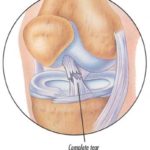ACL Blog 2 – Accelerated versus Non-Accelerated Protocols

In my last blog, I discussed some of the background behind an ACL injury and briefly touched on accelerated vs non-accelerated protocols. In this blog we’ll look at the differences between the two by comparing it with my own non-accelerated conservative approach (loosely based off Fowler Kennedy’s protocol) to a higher-level athlete’s accelerated approach (Advanced Continuing Education Institute).
Here’s what the research says:
Current research shows that compliance with an accelerated rehab protocol significantly improved thigh muscle strength at 3 months compared to a non-accelerated protocol. However, there was no significant difference at the 6, 12 or 24-month timelines (Beynnon et al., 2011). Furthermore, Fukuda et al., (2013) showed that early open-kinetic chain exercises initiated at Week 4 improved quad muscle strength earlier (19 weeks) compared to late open kinetic chain exercises (17 months). Sekir et al (2010) mirrored these findings by showing increased hamstring strength, decreased swelling and giving way episodes, but also showed a significant improvement in activities of daily living at one month post-op using an accelerated protocol. This is important as activities of daily living (personal hygiene, shower/bathing, etc) are an important factor to quality of life and definitely the most frustrating part of the initial stages of rehab (especially if you were like me and only feather weight bearing for 6 weeks)!
Considering this evidence, why not do an accelerated 6-month protocol vs. a 12-month non-accelerated protocol? Once again, it’s patient and surgeon specific! In my clinical experience, I find most surgeons implement a conservative protocol to protect their reconstruction. The outlier is a high-level pro/ semi-pro athlete where surgeons often pick an aggressive accelerated protocol and early return to play.
But remember, it’s not just being physically prepared. A large portion of this injury is actually psychological. The most notable study by Beynnon et al. (2011), found that there was no difference in laxity, proprioception, clinical assessments, patient satisfaction or functional performance (one leg hop test) between accelerated and non-accelerated rehab. What is interesting from this study is that both groups continued to report an impaired quality of life 2 years post-op. Considering these findings, it’s important to note that the protocol only addresses physical milestones and that rehab does not end when the protocol ends.
It is also important to note that as a clinician, you have to clinically reason. Just because the protocol says you can initiate running at 3 months, does not necessarily mean your athlete has the proper movement patterns, strength or confidence to do so! I’ll use my own rehab as an example for this one. I was 4 days post surgery (remember I was a patellar tendon graft). Generally, clinicians use neuromuscular electrical simulation (NMES) in the early stages to re-activate the quads. In my case, my therapist was so focused on sticking to the protocol that she put the stim on and began turning it up. So yes, she was firing up my quads again, but she was also pulling on my donor site (patellar tendon), which led to many tears and a long painful night. Assess and re-assess! Protocols are loose guidelines and are not intended to substitute clinical reasoning.
Personally, I would say that even though it took me 15 months to step on to the soccer pitch again, it took me about 1 full season to feel comfortable making sharp turns, going into tackles and feeling like I was the player before my injury. So could an accelerated protocol have gotten me on the pitch faster? Most likely from a physical standpoint. But like I said in my last blog, I wouldn’t change a thing. The fear of re-rupturing would have overridden my desire to play.
Below is a timeline of my own rehab protocol (non-accelerated, conservative) vs. an accelerated rehab protocol (Advanced Continuing Education Institute). You’ll note the earlier: weight bearing, strengthening, proprioceptive retraining, running, agility and return to play.
ACL chart – Chart will open in a separate page
For the final part of the ACL series, we’ll look at ACL prevention programs and more specifically the FIFA 11+.
References:
“Accelerated Rehabilitation Following Reconstruction”. Advanced Continuing Education Institute. N.p., 2010. Web. 1 May 2016.
Beynnon BD, Johnson RJ, Naud S, Fleming BC, Abate JA, Brattbakk B & Nichols CE (2011). Accelerated versus non-accelerated rehabilitation after anterior cruciate ligament reconstruction: a prospective, randomized, double blind investigation evaluating knee joint laxity using roentgen stereophotogrammetric analysis. AM J Sports Med., 39 (12)., 2536-48.
Fukuda TY, Fingerhut D, Moreira VC, Camarini PM, Scodeller NF, Duarte A Jr, Martinelli M, Bryk FF (2013). Open kinetic chain exercises in a restricted range of motion after anterior cruciate ligament reconstruction: a randomized controlled clinical trial. Am J Sports Med.;41:788–794.
Management of Anterior Cruciate Ligament Injuries: Evidence-Based Clinical Practice Guideline (2014). Rosemont, IL: American Academy of Orthopaedic Surgeons.
“Physiotherapy Following ACL Reconstruction Protocol”. Fowler Kennedy. N.p., 2015. Web. 1 May 2016.
Sekir U, Gur H, Akova B. Early versus late start of isokinetic hamstring-strengthening exercise after anterior cruciate ligament reconstruction with patellar tendon graft (2010). Am J Sports Med. Mar;38(3):492-500.
